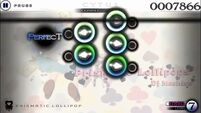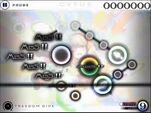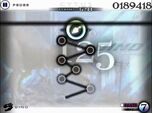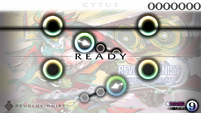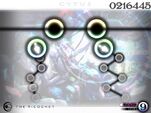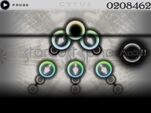(Editing this page was about as tedious as waiting for Persona 5. Please check for mistakes.) Tag: sourceedit |
(→Notes) Tags: Visual edit apiedit |
||
| Line 52: | Line 52: | ||
**If you drag your finger too early/too late/not following the track, the notes are rated as '''Miss'''. |
**If you drag your finger too early/too late/not following the track, the notes are rated as '''Miss'''. |
||
*If the origin (arrow) note fades color, this is not to be mistaken as a bug. It is caused by pressing on the origin much earlier compared to the actual timing, which causes that origin to be registered as a Black Perfect. |
*If the origin (arrow) note fades color, this is not to be mistaken as a bug. It is caused by pressing on the origin much earlier compared to the actual timing, which causes that origin to be registered as a Black Perfect. |
||
| + | *It is possible to tap the drag notes. They will still register, but in most cases, dragging them is more recommended. This technique is useful in songs like [[The Black Case]] and [[Just A Trip]]. |
||
==Gallery== |
==Gallery== |
||
<gallery orientation="landscape" widths="150" captionalign="center" spacing="small"> |
<gallery orientation="landscape" widths="150" captionalign="center" spacing="small"> |
||
Revision as of 08:46, 1 October 2016
Drag notes are small notes connected to each other by a track, that can be followed by dragging along its path as the scan line moves. The track starts with an arrow determining the direction to the next note. Note that these tracks do not continue over between scrolls of the scan line. Rather, a new track is formed when a path is continued over to a new scan line page.
| SOME NOTICEABLE DRAG NOTE TRACKS | |
|---|---|
| Straight Tracks | These are the simplest tracks in the game, only travelling in a vertical line up or down the scan line. They can range in length and density, and they can also be used in combination with other note types (ex. Requiem's beginning). |
| Slanted Tracks | These tracks are a lot more common than straight tracks, and aren't much more complex than them, either. They can be steep (ex. Morpho's ending), almost flat (ex. L7 : Almighty's ending), or from corner to corner (ex. Holy Knight's ending). |
| Curved Tracks (C-drags) | These tracks are much smoother than most, generally lacking sharp turns to provide a more flowing motion. They can be gentle curves (ex. Angelic Sphere), or wildly swerving tracks (ex. Qualia and Conflict). |
| Sharp-Turn Tracks (V-drags) | On the contrary to curved tracks, these types of drags take a sharp turn in their path, requiring the player to suddenly alter their direction. Though generally not too troublesome, a very sharp turn may cause the player to hit the notes on the track out of order (ex. Entrance on Easy). |
| Zigzag Tracks | These tracks are a continuation of the sharp-turn tracks, taking multiple sharp turns to create a distinct zigzag pattern. Generally, each turning point holds a drag note (AKA "two-point zigzags", ex. Dino), though sometimes notes will be thrown between turning points as well (AKA "three-point zigzags", ex. ∅ (Slit) I). A trick exists to tackle these drags, in which the player uses two to three adjacent fingers (depending on the zigzag type) in order to hit the notes in order without following the track itself. |
| Complex Tracks | These tracks have no distinct patterns, generally swerving and darting in multiple directions to confuse the player. They require their own personal techniques to conquer with perfection. Examples can be located in certain parts of GENESYS and L. |
| Identical Double Tracks | These drag types require the player to slide along two identical tracks in unison, with the tracks either being parallel or mirrored, but the pathways still matching. These tracks can follow any of the previously listed formats, from double-straights (ex. The Ricochet's beginning) to double curves (ex. Molto Allegro), and even double-zigzags (ex. Violet). |
| Non-Identical Double Tracks | Tracks like these appear in harder songs such as Requiem and The Ricochet, in which two tracks must be followed in unison, but the tracks themselves. They may start and end at different times, swerve in different directions, or even utilize two completely different drag formats. |
| Triple Tracks | Though found rarely, these drag types aren't too difficult to handle. They require the player to slide across three tracks in unision, forcing thumb players to use extra fingers for full results. The most notable example lies within Stardust Sphere. |
| Alternating Tracks | These tracks are generally quite short, alternating directions with every new track. They can appear in any format, though more often than not they'll be slanted. The best example for this is in Prismatic Lollipops. |
| Revolving Tracks | These tracks are most notable in Freedom Dive and Blue Eyes, with a revolving track that goes up and down the scan line, all while click notes inhabit the interior of the track. A generally accepted technique against this drag type is to alternate hands between the passing scan line, designating the free hand to hitting the notes inside. |
| Rapid-Succession Tracks | These drag types throw rapid successions of tracks at the player, with the tracks themselves being far apart from each other, and often adapting differing patterns. Depending on the player's reflexes and coordination, they may choose to use multiple hands or just one. Examples can be found in parts of The Red Coronation and L. |
| Click + Drag Combination | A miscellaneous type of drag note, in which a click note appears shortly before a drag note. By sliding straight from tapping the click note, without lifting his/her finger from the screen, the player can successfully cause both notes to register as "Perfect". This can be used as a basic advantage in songs like First Gate and Revoluxionist, though it serves to be a compulsory skill in the game's "demon" songs (ex. L2 - Ascension: Act 2 (Liberation)). |
Drag notes are quite a varible type of note, ranging from being used in abundance (ex. L) to not being used at all (ex. Q). They can also be used in creating notable easter egg patterns, with the most notable being the jack-o-lantern face in Halloween Party.
Notes
- There are only 3 ratings for Drag notes, Colour Perfect, Black Perfect and Miss.
- If you drag your finger across the small note at the correct timing, the note is rated as Colour Perfect.
- If you drag your finger quite before or after the scan line, the note is rated as Black Perfect.
- If you drag your finger too early/too late/not following the track, the notes are rated as Miss.
- If the origin (arrow) note fades color, this is not to be mistaken as a bug. It is caused by pressing on the origin much earlier compared to the actual timing, which causes that origin to be registered as a Black Perfect.
- It is possible to tap the drag notes. They will still register, but in most cases, dragging them is more recommended. This technique is useful in songs like The Black Case and Just A Trip.

